Today the Church celebrates the feast of St. Elizabeth of Hungary, a 13th-century lay Franciscan known for her charity toward the poor and needy in her midst. May her prayers and holy example inspire us to grow in our loving service of our neighbor.
Today the Church celebrates the feast of St. Elizabeth of Hungary, a 13th-century lay Franciscan known for her charity toward the poor and needy in her midst. May her prayers and holy example inspire us to grow in our loving service of our neighbor.
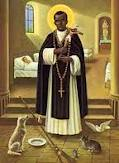 Today is the feast of St. Martin de Porres, one of the most beloved saints in the history of the Church. I thought I would share with readers the following excerpt from the homily of Blessed John XXIII on the occasion of St. Martin’s canonization in 1962, taken from the Office of Readings for today:
Today is the feast of St. Martin de Porres, one of the most beloved saints in the history of the Church. I thought I would share with readers the following excerpt from the homily of Blessed John XXIII on the occasion of St. Martin’s canonization in 1962, taken from the Office of Readings for today:
The example of Martin’s life is ample evidence that we can strive for holiness and salvation as Christ Jesus has shown us: first, by loving God with all your heart, with all your soul, and with all your mind; and second, by loving your neighbor as yourself.”
When Martin had come to realize that Christ Jesus suffered for us and that he carried our sins on his body to the cross, he would meditate with remarkable ardor and affection about Christ on the cross. Whenever he would contemplate Christ’s terrible torture he would be reduced to tears. He had an exceptional love for the great sacrament of the Eucharist and often spent long hours in prayer before the blessed sacrament. His desire was to receive the sacrament in communion as often as he could.
Saint Martin, always obedient and inspired by his divine teacher, dealt with his brothers with that profound love which comes from pure faith and humility of spirit. He loved men because he honestly looked on them as God’s children and as his own brothers and sisters. Such was his humility that he loved them even more than himself and considered them to be better and more righteous than he was.
He excused the faults of others. He forgave the bitterest injuries, convinced that he deserved much severer punishments on account of his own sins. He tried with all his might to redeem the guilty; lovingly he comforted the sick; he provided food, clothing and medicine for the poor; he helped, as best he could, farm laborers and Negroes, as well as mulattoes, who were looked upon at that time as akin to slaves: thus he deserved to be called by the name the people gave him: ‘Martin of Charity.'”
The virtuous example and even the conversation of this saintly man exerted a powerful influence in drawing men to religion. It is remarkable how even today his influence can still come us toward the things of heaven. Sad to say, not all of us understand these spiritual values as well as we should, nor do we give them a proper place in our lives. Many of us, in fact, strongly attracted by sin, may look upon these values as of little moment, even something of a nuisance, or we ignore them altogether. It is deeply rewarding for men striving for salvation to follow in Christ’s footsteps and to obey God’s commandments. If only everyone could learn this lesson from the example that Martin gave us.
St. Martin de Porres was born in Lima, Peru in 1579 as the illegitimate son of a Panamanian mother and a Spanish father. Having inherited the dark color of his mother, he was rejected by his father and was therefore raised in poverty. He entered the Dominicans and became renowned for his countless works of charity. St. Martin was the friend of another great Dominican Saint from Peru, St. Rose of Lima, and his bishop for a time was St. Turibius of Mogrovejo.
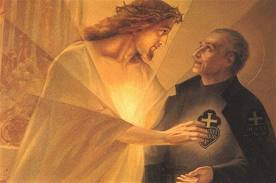 Today the Church in the United States celebrates the memorial of St. Paul of the Cross (194-1775), the founder of the Congregation of the Discalced Clerks of the Most Holy Cross and Passion of Our Lord Jesus Christ, more commonly known as the “Passionists.” (For a concise explanation as to why it’s celebrated today, click here.) There are three Passionist communites for women in the United States that are affiliates of the Institute on Religious Life.
Today the Church in the United States celebrates the memorial of St. Paul of the Cross (194-1775), the founder of the Congregation of the Discalced Clerks of the Most Holy Cross and Passion of Our Lord Jesus Christ, more commonly known as the “Passionists.” (For a concise explanation as to why it’s celebrated today, click here.) There are three Passionist communites for women in the United States that are affiliates of the Institute on Religious Life.
St. Paul was one of the greatest preachers of his age, and also was a renowned miracle worker and spiritual director.
In looking into St. Paul of the Cross’ remarkable life, I came across a documentary about him by actor Martin Sheen. It’s quite informative. Here is the first 13-min. installment, and here is the second 13-min. installment.
Speaking of Martin Sheen, check out this interview concerning The Way, an inspiring new movie written and directed by his son (Emilio, not Charlie!).
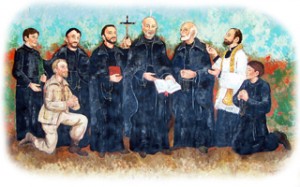 The blood of the martyrs is the seed of the Church. Today we remember and celebrate the planting of the Church in North America through the martyrdom of the Jesuit martyrs Isaac Jogues, John de Brebeuf, and companions. In honor of these true heroes of the faith, enjoy this short video with Fr. James Kobicki, S.J. of the Apostleship of Prayer.
The blood of the martyrs is the seed of the Church. Today we remember and celebrate the planting of the Church in North America through the martyrdom of the Jesuit martyrs Isaac Jogues, John de Brebeuf, and companions. In honor of these true heroes of the faith, enjoy this short video with Fr. James Kobicki, S.J. of the Apostleship of Prayer.
May the courage of these martyrs, rooted in the love of God, inspire us to live wholeheartedly for Christ today, and to offer our own sufferings in union with Christ for the life of the world.
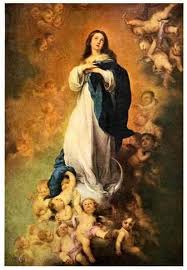 While today is the solemnity of the Assumption of the Blessed Virgin, it is not a holy day of obligation this year because it falls on a Monday. Still, it’s a special feast day and we do well to celebrate as much as our state in life allows.
While today is the solemnity of the Assumption of the Blessed Virgin, it is not a holy day of obligation this year because it falls on a Monday. Still, it’s a special feast day and we do well to celebrate as much as our state in life allows.
The dogma that Our Lady was taken body and soul to heaven upon the completion of her earthly life was pronounced in an ex cathedra statement by Pope Pius XII in a 1950 bull entitled Munificentissimus Deus and is also found in paragraph 966 of the Catechism of the Catholic Church.
At the close of Munificentissimus Deus, Pope Pius XII tells us why this feast should matter to all of us:
“[T]his solemn proclamation and definition of the Assumption will contribute in no small way to the advantage of human society, since it redounds to the glory of the Most Blessed Trinity, to which the Blessed Mother of God was bound by such singular bonds. It is to be hoped that all the faithful will be stirred up to a stronger piety toward their heavenly Mother, and that the souls of all those who glory in the Christian name may be moved by the desire of sharing in the unity of Christ’s Mystical Body and of increasing their love for her who in all things shows her motherly heart to the members of [Christ’s] Body. . . . In this magnificent way, all may see clearly to what a lofty goal our bodies and souls are destined. Finally, it is our hope that belief in Mary’s bodily Assumption into heaven will make our belief in our own resurrection stronger and render it more effective.”
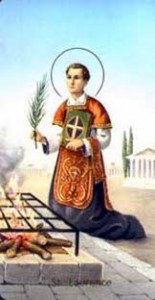 Today is the feast of St. Lawrence of Rome, one of the most famous deacons in Church history. With the restoration of the permanent diaconate over the past forty years, St. Lawrence has come to serve as an important model and patron saint for the thousands of men now serving the Church as deacons.
Today is the feast of St. Lawrence of Rome, one of the most famous deacons in Church history. With the restoration of the permanent diaconate over the past forty years, St. Lawrence has come to serve as an important model and patron saint for the thousands of men now serving the Church as deacons.
Butler’s Lives of the Saints tells a beautiful story about Saint Lawrence that captures the essence of what it truly means to be a deacon. In the year 258, Lawrence was serving Pope Sixtus II as a deacon in Rome. The Holy Father was led out to martyrdom, and St. Lawrence stood by, weeping that he could not share his fate. “I was your minister,” he said, “when you consecrated the blood of Our Lord; why do you leave me behind now that you are about to shed your own?”
The holy Pope comforted him with the words, “Do not weep, my son; in three days you will follow me.” This prophecy came true.
The political ruler of the city knew the rich offerings which the Christians put into the hands of the clergy, and he demanded the treasures of the Roman Church from Lawrence, their guardian. The Saint promised, at the end of three days, to show him riches exceeding all the wealth of the empire, and set about collecting the poor, the infirm, and the religious who lived by the alms of the faithful. He then invited the official to “see the treasures of the Church.”
Shortly after that, on August 10, 258, St. Lawrence was burned alive as a martyr for the Christian faith.
Deacons are members of the clergy, but they are not priests. Rather, they are ordained for service (diakonia), as living icons of Christ, who came not to be served, but to serve, and to give His life as a ransom for many (Mk. 10:45).
This episode from St. Lawrence’s life exemplifies the deacon’s call to look out for the needs of the poor and needy, not out of mere duty, but because they are the treasures of the Church. May all of us learn to love and serve Christ by seeing Him in those around us who are most in need of His compassion right now.
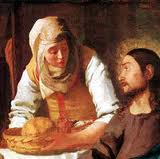 As Catholics, we try to balance in our lives of faith the active Martha and the contemplative Mary. Sometimes in the process Martha gets a bad rap. She’s anxious and worried about many things (Luke 10:41), so at times we might picture her as a frantic busybody flitting about, doing 101 things, while the serene Mary sits at the feet of Jesus.
As Catholics, we try to balance in our lives of faith the active Martha and the contemplative Mary. Sometimes in the process Martha gets a bad rap. She’s anxious and worried about many things (Luke 10:41), so at times we might picture her as a frantic busybody flitting about, doing 101 things, while the serene Mary sits at the feet of Jesus.
But today is the feast of Saint Martha. She is a full-fledged saint, with all the rights and privileges that go with it! While activism without prayer can quickly turn into mere workaholism; prayer without active apostolate also lacks authenticity.
At this exciting time in the Church, priests, religious, and laity are called to roll up our sleeves and actively participate in the great work of the new evangelization. There’s plenty to do to keep all of us Martha’s busy.
May we imitate the faith of St. Martha, who said, “I have come to believe that you are the Messiah, the Son of God” (John 11:27). And, like St. Martha, may we express this faith in active works of charity.
As we do so, we must keep in mind the clear teaching of Scripture. Our Lord said that Mary chose the better part, the one necessary thing (Luke 10:42). Our Lord is truly present at every Mass and in every tabernacle throughout the world. If we truly desire to be saints, to become the holy men and women God calls us to be, we do well–frequently and with much love and devotion–to return to the Source: Jesus, Our Eucharistic Lord.
I think St. Martha would wholeheartedly agree.
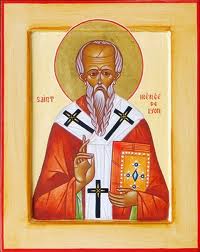 The following is taken from the Office of Readings for today’s feast of St. Irenaeus, an important second-century bishop and Father of the Church. This selection from St. Irenaeus contains the famous quote that is sometimes translated, “The glory of God is man fully alive, and the life of man is the vision of God.”
The following is taken from the Office of Readings for today’s feast of St. Irenaeus, an important second-century bishop and Father of the Church. This selection from St. Irenaeus contains the famous quote that is sometimes translated, “The glory of God is man fully alive, and the life of man is the vision of God.”
The glory of God gives life; those who see God receive life. For this reason God, who cannot be grasped, comprehended or seen, allows himself to be seen, comprehended and grasped by men, that he may give life to those who see and receive him. It is impossible to live without life, and the actualization of life comes from participation in God, while participation in God is to see God and enjoy his goodness. Continue reading Man Alive!
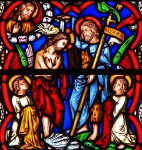 Today is the tenth birthday of my son Samuel John. It’s also the liturgical feast of the Birth (or “Nativity”) of St. John the Baptist. It’s one of the three birthdays set aside for special celebration in the Church, the others of course being the Birth of Jesus (Christmas) on December 25th, and the Nativity of the Blessed Virgin Mary on September 8th.
Today is the tenth birthday of my son Samuel John. It’s also the liturgical feast of the Birth (or “Nativity”) of St. John the Baptist. It’s one of the three birthdays set aside for special celebration in the Church, the others of course being the Birth of Jesus (Christmas) on December 25th, and the Nativity of the Blessed Virgin Mary on September 8th.
I thought I would refer our readers to this 2007 article at Catholic Exchange on the birth of St. John the Baptist. I especially appreciate the author’s focus on St. John’s vocation as it unfolded throughout the life of the herald of the Messiah: Continue reading The Vocation of St. John the Baptist
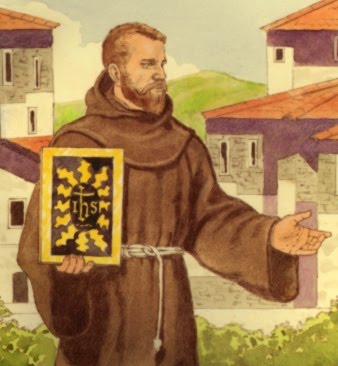 Today the Church celebrates the feast day of St. Bernardine of Siena. As a child in Southern California, I never heard about St. Bernardine, though the nearby city of San Bernardino (my brother called it “San Ber-doo”) was named after him. I only later learned that this 15th-century Franciscan priest was quite a dynamic evangelist and preacher.
Today the Church celebrates the feast day of St. Bernardine of Siena. As a child in Southern California, I never heard about St. Bernardine, though the nearby city of San Bernardino (my brother called it “San Ber-doo”) was named after him. I only later learned that this 15th-century Franciscan priest was quite a dynamic evangelist and preacher.
He is perhaps best known for fostering devotion to the Holy Name of Jesus. His “MO” was to travel from city to city throughout all of Italy carrying a banner with the large letters “IHS” (more on that in a minute) encircled by twelve golden rays surmounted by a cross.
I’ve always been curious about the “IHS,” which is found (thanks in large part to St. Bernardine) in many Catholic churches and on many religious items. There has been a certain amount of confusion on this. Some say it signifies “In hoc Signo vinces” (“In this Sign you will conquer,” referring to Constantine’s famous vision, with the nails on the emblem forming the “v”), while others say it’s the first letters of Jesus Hominum Salvator (“Jesus, Savior of Mankind”).
The most plausible and widely accepted interpretation that I’ve encountered is that it’s simply an abbreviated form of the name of Jesus, as it appears in Greek, The earliest recorded use of this monogram appears to be the eighth century.
Aside from all the history behind it, the important thing is that “IHS” has come to be recognized as a familiar symbol of the Holy Name of Jesus, a symbol that has been popularized over the past 500 years by Franciscans, Dominicans, and Jesuits. May we recognize, especially in our use of language, the holiness of the name before which “every knee shall bend” (Phil. 2:10).
Let’s close with the prayer of the Church:
Father,
You gave Saint Bernardine a special love
for the holy name of Jesus.
By the help of his prayers,
may we always be alive with the spirit of Your love.
We ask this through our Lord Jesus Christ, Your Son,
who lives and reigns with You and the Holy Spirit,
one God, for ever and ever. +Amen.